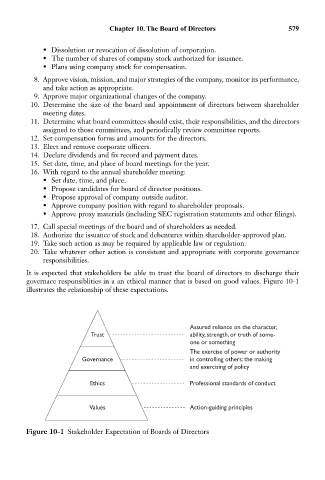Page 593 - Bruce Ellig - The Complete Guide to Executive Compensation (2007)
P. 593
Chapter 10. The Board of Directors 579
• Dissolution or revocation of dissolution of corporation.
• The number of shares of company stock authorized for issuance.
• Plans using company stock for compensation.
8. Approve vision, mission, and major strategies of the company, monitor its performance,
and take action as appropriate.
9. Approve major organizational changes of the company.
10. Determine the size of the board and appointment of directors between shareholder
meeting dates.
11. Determine what board committees should exist, their responsibilities, and the directors
assigned to those committees, and periodically review committee reports.
12. Set compensation forms and amounts for the directors.
13. Elect and remove corporate officers.
14. Declare dividends and fix record and payment dates.
15. Set date, time, and place of board meetings for the year.
16. With regard to the annual shareholder meeting:
• Set date, time, and place.
• Propose candidates for board of director positions.
• Propose approval of company outside auditor.
• Approve company position with regard to shareholder proposals.
• Approve proxy materials (including SEC registration statements and other filings).
17. Call special meetings of the board and of shareholders as needed.
18. Authorize the issuance of stock and debentures within shareholder-approved plan.
19. Take such action as may be required by applicable law or regulation.
20. Take whatever other action is consistent and appropriate with corporate governance
responsibilities.
It is expected that stakeholders be able to trust the board of directors to discharge their
governace responsiblities in a an ethical manner that is based on good values. Figure 10-1
illustrates the relationship of these expectations.
Assured reliance on the character,
Trust ability, strength, or truth of some-
one or something
The exercise of power or authority
Governance in controlling others; the making
and exercising of policy
Ethics Professional standards of conduct
Values Action-guiding principles
Figure 10-1 Stakeholder Expectation of Boards of Directors

